Cisco has played a significant role in shaping the landscape of the Internet of Things (IoT) through its innovative technologies and solutions. As one of the leading networking companies in the world, Cisco has been at the forefront of driving the adoption of IoT across various industries.
One of the key contributions of Cisco to the IoT landscape is its networking infrastructure. With its extensive portfolio of networking products and solutions, including switches, routers, and security devices, Cisco has provided the backbone for connecting IoT devices and enabling seamless communication between them. This robust network infrastructure has helped organizations deploy IoT solutions more efficiently and securely.
In addition to networking infrastructure, Cisco has also developed a range of IoT-specific solutions that cater to different industry verticals. These solutions leverage Cisco’s expertise in networking, security, and data analytics to enable organizations to collect, analyze, and act on data generated by IoT devices. For example, Cisco’s IoT Field Network Director helps organizations manage and monitor their IoT devices in real-time, while its IoT Security Platform provides end-to-end security for IoT deployments.
Furthermore, Cisco has been actively involved in standardizing IoT protocols and technologies to ensure interoperability and seamless integration between different IoT devices and platforms. The company has been a key contributor to organizations such as the Industrial Internet Consortium (IIC) and the Internet Engineering Task Force (IETF), working collaboratively to establish common standards and best practices for IoT deployments.
Moreover, Cisco’s partnerships with other technology companies and industry players have also been instrumental in shaping the IoT landscape. By collaborating with companies such as Intel, IBM, and Microsoft, Cisco has been able to develop integrated solutions that address the diverse needs of IoT deployments across industries.
As the IoT landscape continues to evolve, Cisco remains committed to driving innovation and driving the adoption of IoT technologies. With its comprehensive portfolio of networking products, IoT solutions, and industry partnerships, Cisco is well-positioned to continue shaping the future of IoT and enabling organizations to realize the full potential of connected devices and data.










